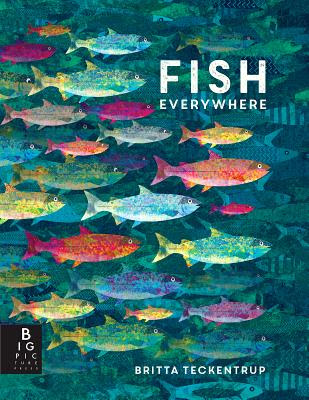It's August. I thought I'd mention that in case you are feeling as time-disoriented as I sometimes am these days. That means it's FISHING season, regardless of where you find yourself (at least in the Northern Hemisphere). Whether you are an avid angler or wrinkle your nose at the thought of baiting a hook, a recent non-fiction picture book is a must-read.
FISH EVERYWHERE, was created by multi-award-winning Brita Teckentrup. This London-based creator is a fine-artist, illustrator, author, and remarkably effective science educator. The shimmery, embossed and texturized cover invites readers of any age to begin with a leisurely and curious examination of these schooled fish. Each shape, size and color suggests the remarkable diversity among the vertebrate fish pictured. Even at a glance, their individual eyes reveal the fact that fish have brains, complex nervous systems, and pursue individual purposes, even when schooled. This cover is an ideal invitation to meet these fish you will want to know more about.Teckentrup provides a brilliant introduction to fish on our planet, launching the book with a double spread challenge to find images that are NOT fish from among the clearly labeled images. Successive spreads offer STEM content at its best, with intriguing and labeled science diagrams of a "bony" fish and a "cartilaginous" fish. There is no shying away from accuracy in language and content, yet the images and main text make the science content understandable for even youngest readers, at least in conversation with adults.
The page-turns progress from early evolutionary fish history through varied habitats, always including sidebar illustrations and brief text with information and/or questions. Various pages also feature "Can you find it?" insets, food chain patterns, oddities of various species, survival strategies and adaptations, and reproduction patterns.
In the concluding spreads the role of PEOPLE in relation to FISH is explored briefly, but effectively, revealing disruptions to nature's millions of years of FISH development, along with examples of kid-friendly changes in daily behaviors and choices that can have significant positive effects on FISH!
Teckentrup's informative and somewhat intense treatment of FISH called to mind a timeless picture book favorite of mine, SWIMMY, created by another globally acclaimed author/illustrator, Leo Lionni. These two gorgeous books would make a brilliant shared experience, offering comparisons of fiction and non-fiction picture books, art techniques, intended purposes and uses, and verse/voice styles.
My Covid 19 anchor in time:
Throughout my long teaching experience, at many grades, I shared SWIMMY during the first days and weeks of school. The direct (but lyrically light) message in this classic is that we do our best (not just survive, but THRIVE) when we work together. FISH EVERYWHERE reveals that truth, too, within it's scientific exploration of patterns and species adaptations.
This commonality feels especially suitable as we face the stressed and distressed return to school, in one form or another, or many forms. For all the legitimate concern about providing social interaction for developing learners, books like SWIMMY and FISH EVERYWHERE invite us all to recognize that we are all, ALL OF US, residents of the same planet, inhabiting this social world together, and are in a multitude of ways connected in our various learning/working settings. Rather than adopting a survivalist/predatory approach to our choices, reaching beyond ourselves to explore a broader landscape of needs is a choice each of us can make. In the process, we can make those choices better for ourselves and the broader society.
Shouldn't we try that as often as possible?


No comments:
Post a Comment